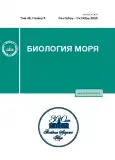The Disease of the Scallop Mizuhopecten yessoensis (Jay, 1857) in the Mariculture Farms of Prymorye Caused by Protozoa of the Genus Perkinsus Levine, 1978
- Authors: Boutorina T.E.1, Degteva E.D.1
-
Affiliations:
- Far Eastern State Technical Fisheries University
- Issue: Vol 49, No 5 (2023)
- Pages: 353-358
- Section: КРАТКИЕ СООБЩЕНИЯ
- Published: 01.09.2023
- URL: https://journals.rcsi.science/0134-3475/article/view/140793
- DOI: https://doi.org/10.31857/S0134347523050066
- EDN: https://elibrary.ru/EOIUZP
- ID: 140793
Cite item
Full Text
Abstract
The results of a study of the cultivated yesso scallop Mizuhopecten yessoensis (Jay, 1857) in Primorsky Krai in 2014–2021 are presented. The death of molluscs in mariculture farms was noted, the symptoms of the “dermo” disease were studied: high mortality of scallops that have reached two years of age, observed during autumn displacement into new cages in September, the presence of protozoa of the genus Perkinsus Levine, 1978 in the tissues of organs, foci of damage of the adductor muscle, non-closure of the shell valves, black discoloration, necrotizing of soft tissues. The minimum level of the parasitic load was established: 10–15 pa-rasitic hypnospores per mollusc. However, considering the danger of a disease that causes mass death of molluscs for several years, the rapid spread of the pathogen, significant economic losses, it is recommended to create a specialized laboratory in the region for diagnosing and constantly monitoring the state of mariculture farms.
About the authors
T. E. Boutorina
Far Eastern State Technical Fisheries University
Author for correspondence.
Email: boutorina@mail.ru
Russia, 690087, Vladivostok
E. D. Degteva
Far Eastern State Technical Fisheries University
Email: boutorina@mail.ru
Russia, 690087, Vladivostok
References
- Бочаров Л.Н., Поздняков С.Е., Гаврилова Г.С. и др. Развитие аквакультуры в Приморье: реалии и возможности // Вопр. рыболовства. 2015. Т. 16. № 1. С. 7–23.
- Бровкина Е.П., Костина Е.А. Характер протекания эпизоотий при садковом выращивании гребешка в Приморье. Перкинсус – вероятная причина возникновения данных заболеваний // Науч. тр. Дальрыбвтуза. 2020. Т. 53. № 3. С. 41–52.
- Брыков В.А., Колотухина Н.К. Биологические основы культивирования приморского гребешка в прибрежных водах Приморского края // Вопр. рыболовства. 2010. Т. 11. № 3 (43). С. 564–586.
- Буторина Т.Е., Творогова Е.В. Заражение моллюсков динофлагеллятами рода Perkinsus: этиология, клинические признаки, распространение, диагностика // Актуальные проблемы освоения биологических ресурсов Мирового океана. Материалы IV Международной научно-технической конференции. Владивосток, 24–26 мая 2016 г. Ч. 1. Владивосток: Дальрыбвтуз. 2016. С. 49–53.
- Буторина Т.Е., Кулепанов В.Н., Зверева Л.В. Болезни и паразиты культивируемых и промысловых беспозвоночных и водорослей. СПб.: Лань. 2018. 124 с.
- Воронин В.Н., Кузнецова Е.В., Стрелков Ю.А., Чернышёва Н.Б. Болезни рыб в аквакультуре. Практическое руководство. СПб.: Изд-во ФГНУ “ГосНИОРХ”. 2011. 264 с.
- Габаев Д.Д., Айздайчер Н.А. Воспроизводство некоторых двустворчатых моллюсков в Приморье (Японское море) // Бюлл. Дальневост. малакол. об-ва. 2012. Т. 15/16. С. 135–153.
- Гаврилова Г.С. Марикультура беспозвоночных на Дальнем Востоке: этапы, итоги, задачи // Изв. ТИНРО. 2005. Т. 141. С. 103–120.
- Гаврилова Г.С., Кучерявенко А.В. Продуктивность плантаций двустворчатых моллюсков в Приморье. Владивосток: ТИНРО-центр. 2011. 113 с.
- Гаврилова Г.С., Ким Л.Н. Эффективность культивирования приморского гребешка (Mizuhopecten yessoensis) в Уссурийском заливе (Японское море) // Изв. ТИНРО. 2016. Т. 185. С. 240–250.
- Гаврилова Г.С., Мотора З.И., Поздняков С.Е. Результаты исследований состояния приморского гребешка (Mizuhopecten yessoensis) на плантациях марикультуры Приморья // Изв. ТИНРО. 2021. Т. 201. Вып. 4. С. 895–909.
- Гаевская А.В. Паразиты, болезни и вредители мидий (Mytilus, Mytilidae). 1. Простейшие (Protozoa). Cевастополь: ЭКОСИ-Гидрофизика. 2006. 101 с.
- Ким Г.Н., Лескова С.Е., Матросова И.В. Марикультура. М.: Моркнига. 2014. 273 с.
- Лагунова Д.Д., Герасимова Е.А., Чернецов В.В. Эффективность выращивания гребешка комбинированным способом (сочетание подвесного и донного) // Науч. тр. Дальрыбвтуза. 2010. Т. 22. С. 159–165.
- Макоедов А.Н. Основные тенденции развития аквакультуры // Вопр. рыболовства. 2006. Т. 7. № 3 (27). С. 366–384.
- Audemard C., Reece K.S., Burreson E.M. Real-time PCR for detection and quantification of the protistan parasite Perkinsus marinus in environmental waters // Appl. Environ. Microbiol. 2004. V. 70. № 11. P. 6611–6618.
- Choi K.-S., Park K.-I. Review of the protozoan parasite Perkinsus olseni (Lester and Davis, 1981) infection in Asian waters // Coastal environmental and ecosystem issues of the East China Sea. Nagasaki: TERRAPUB and Nagasaki Univ. 2010. P. 269–281.
- Dungan C.F., Bushek D. Development and applications of Ray’s fluid thioglycollate media for detection and manipulation of Perkinsus spp. pathogens of marine molluscs // J. Invertebr. Pathol. 2015. V. 131. P. 68–82.
- ICES. Dermo diseases of oyster caused by Perkinsus marinus. Revised and updated by S.E. Ford. ICES Identification Leaflets for Diseases and Parasites of Fish and Shellfish. 2011. Leafl. № 30. 5 p.
- Manual of Diagnostic Tests for Aquatic Animals 2023. Sect. 2.4. Ch. 2.4.6. Infection with Perkinsus olseni (version adopted in May 2015). P. 473–484. https://www.woah.org/en/what-we-do/standards/codes-and-manuals/aquatic-manual-online-access. Accessed 10.04.2023.
- Ray S.M. A review of the culture method for detecting Dermocystidium marinum, with suggested modifications and precautions // Proc. Natl. Shellfish Assoc. 1966. V. 54. P. 55–69.
- Villalba A., Reece K.S., Ordas M.K. et al. Perkinsosis in mollusks: a rewiev // Aquat. Living Resour. 2004. V. 17. P. 411–432.











